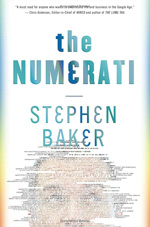Skills as Numbers
 BusinessWeek has an excerpt of Numerati, a book about the fabled monks of data mining (publishers weekly calls them “entrepreneurial mathematicians”) who are sifting through the personal data we create every day.
BusinessWeek has an excerpt of Numerati, a book about the fabled monks of data mining (publishers weekly calls them “entrepreneurial mathematicians”) who are sifting through the personal data we create every day.
Picture an IBM manager who gets an assignment to send a team of five to set up a call center in Manila. She sits down at the computer and fills out a form. It’s almost like booking a vacation online. She puts in the dates and clicks on menus to describe the job and the skills needed. Perhaps she stipulates the ideal budget range. The results come back, recommending a particular team. All the skills are represented. Maybe three of the five people have a history of working together smoothly. They all have passports and live near airports with direct flights to Manila. One of them even speaks Tagalog.
Everything looks fine, except for one line that’s highlighted in red. The budget. It’s $40,000 over! The manager sees that the computer architect on the team is a veritable luminary, a guy who gets written up in the trade press. Sure, he’s a 98.7% fit for the job, but he costs $1,000 an hour. It’s as if she shopped for a weekend getaway in Paris and wound up with a penthouse suite at the Ritz.
Hmmm. The manager asks the system for a cheaper architect. New options come back. One is a new 29-year-old consultant based in India who costs only $85 per hour. That would certainly patch the hole in the budget. Unfortunately, he’s only a 69% fit for the job. Still, he can handle it, according to the computer, if he gets two weeks of training. Can the job be delayed?
This is management in a world run by Numerati.
I’m highly skeptical of management (a fundamentally human activity) being distilled to numbers in this manner. Unless, of course, the managers are that poor at doing their job. And further, what’s the point of the manager if they’re spending most of their time filling out the vacation form-style work order? (Filling out tedious year-end reviews, no doubt.) Perhaps it should be an indication that the company is simply too large:
As IBM sees it, the company has little choice. The workforce is too big, the world too vast and complicated for managers to get a grip on their workers the old-fashioned way—by talking to people who know people who know people.
Then we descend (ascend?) into the rah-rah of today’s global economy:
Word of mouth is too foggy and slow for the global economy. Personal connections are too constricted. Managers need the zip of automation to unearth a consultant in New Delhi, just the way a generation ago they located a shipment of condensers in Chicago. For this to work, the consultant—just like the condensers—must be represented as a series of numbers.
I say rah-rah because how else can you put refrigeration equipment parts in the same sentence as a living, breathing person with a mind, free will and a life.
And while I don’t think I agree with this particular thesis, the book as a whole looks like an interesting survey of efforts in this area. Time to finish my backlog of Summer reading so I can order more books…

